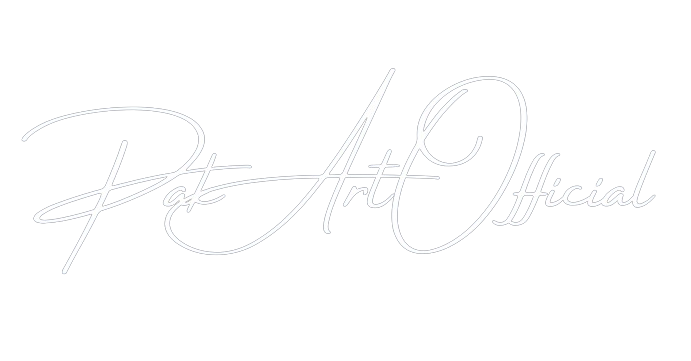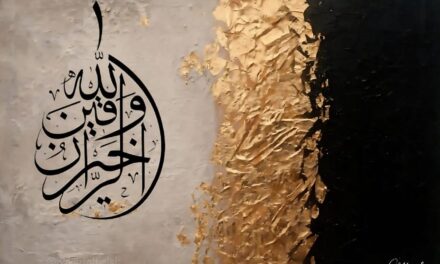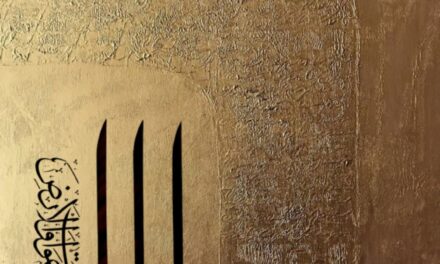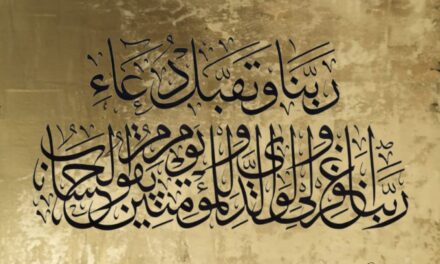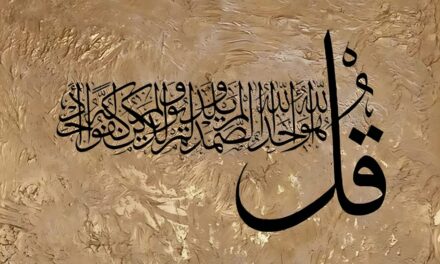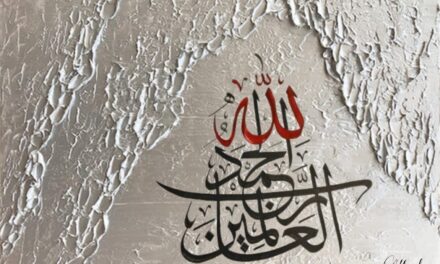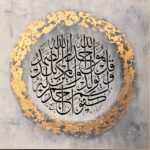
“The Kiswa-e-Kaaba: A Canvas of Faith and Tradition”
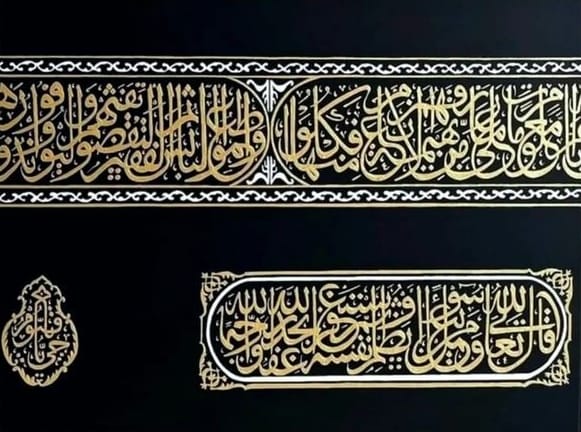
The Kiswa-e-Kaaba, the ceremonial cloth that drapes the Kaaba in Makkah, is not just a piece of fabric; it is a symbol of deep reverence, a testament to Islamic tradition and artistry. This sacred essence is captured in an exquisite acrylic painting, translating the spiritual and historical significance of the Kiswa into a visual narrative.
The Kiswa: A Symbol of Devotion
The Kiswa is much more than a covering for the Kaaba; it’s a symbol of devotion and respect. Historically, the tradition of draping the Kaaba with a new Kiswa dates back centuries, symbolizing renewal and continuous devotion. The Kiswa is changed annually during the Hajj pilgrimage, in a ceremony that reflects the unity and solidarity of the Muslim ummah (community).
Historical and Artistic Significance of the Kiswa
The tradition of the Kiswa dates back to the pre-Islamic era, with the practice being continued and enriched throughout Islamic history. The Kiswa is traditionally made in the city of Makkah or in the nearby city of Jeddah, and now it is crafted in a special factory in Umm al-Joud in Makkah. This factory is dedicated solely to the creation of the Kiswa, employing skilled artisans who use techniques passed down through generations.
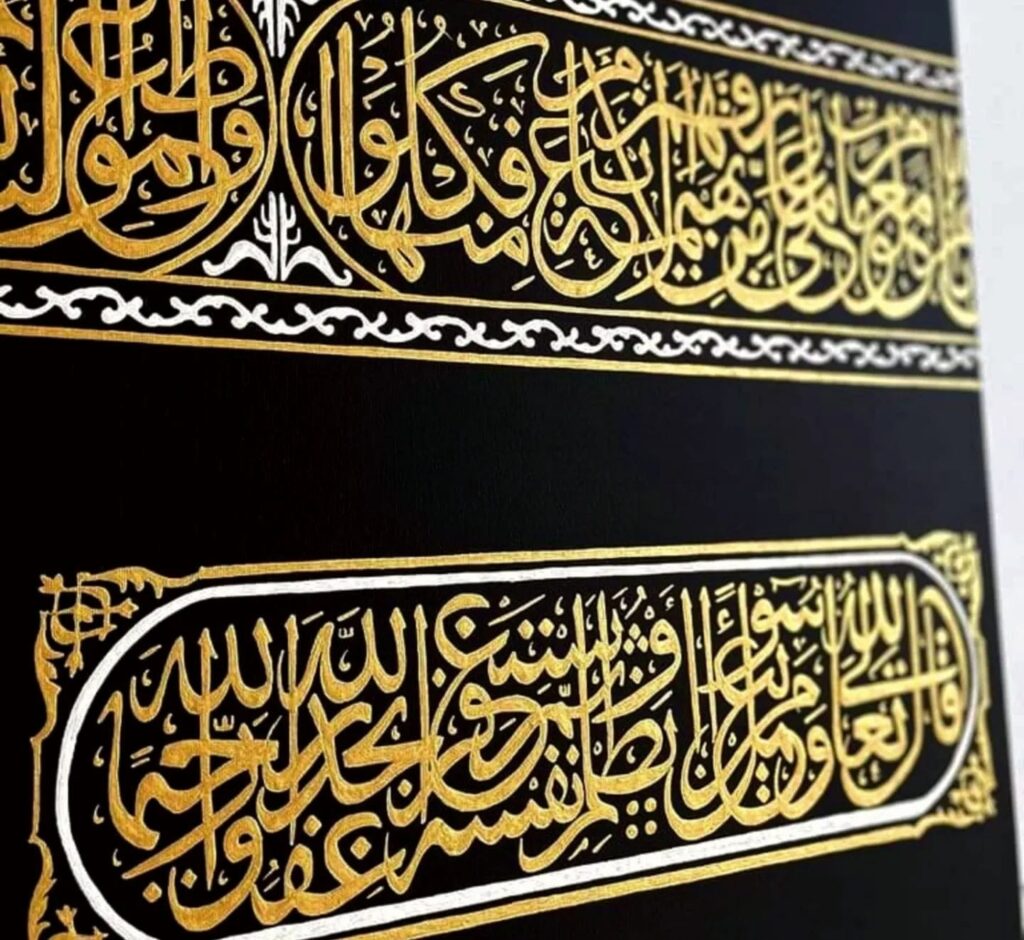
Made from silk and intricately embroidered with gold and silver thread, the Kiswa is an embodiment of Islamic craftsmanship. The designs typically feature Quranic calligraphy, geometric patterns, and floral motifs, each element carrying profound religious symbolism. The process of creating the Kiswa is a revered art form, with skilled artisans dedicating months to its preparation.
Acrylic Interpretation on Canvas
In this painting, the artist has skillfully used acrylics to depict the rich texture and grandeur of the Kiswa. The vibrant, enduring nature of acrylic paint brings out the depth and complexity of the Kiswa’s embroidery. The canvas becomes a realm where the solemn black fabric comes to life, highlighted by the golden and silver thread that forms the calligraphic inscriptions and embellishments.
Detailed Depiction
Every aspect of the Kiswa’s design is captured with precision on the canvas. The Islamic calligraphy, primarily comprising verses from the Quran, is rendered with such detail that it seems to echo the divine words. The geometric patterns and floral motifs are not just decorative elements but symbols reflecting the harmony and order inherent in Islamic art and architecture.
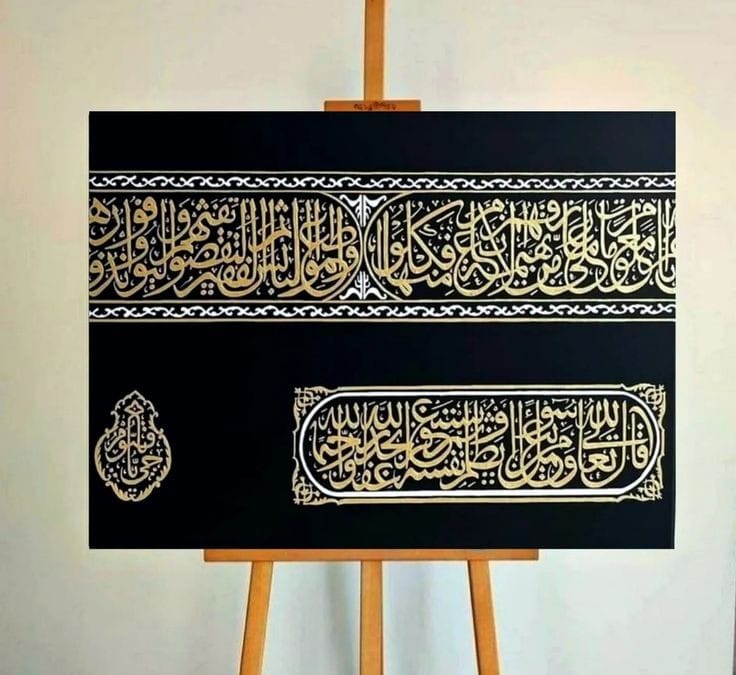
Beyond the Visual
This painting is more than a depiction of a religious artifact; it’s a reflection of the spiritual journey and devotion of millions of Muslims. It symbolizes the link between the earthly and the divine, the material and the spiritual. For viewers, the painting is not just a visual experience but an invitation to explore the depths of Islamic tradition, history, and spirituality.
The Historical Journey of the Kiswa-e-Kaaba
The Kiswa, the cloth that drapes the Kaaba in Makkah, has a rich history steeped in religious, cultural, and artistic significance. This article delves into the historical journey of the Kiswa, tracing its origins and evolution through time.
1. Origins of the Kiswa Tradition
The tradition of covering the Kaaba, known as the Kiswa, dates back to the pre-Islamic era. Various tribal leaders and local rulers would drape the Kaaba with cloths as a symbol of veneration. This practice was adopted and continued by the Prophet Muhammad, solidifying its significance in Islamic tradition.
2. Early Islamic Period
With the advent of Islam, the significance of the Kaaba and the Kiswa rose dramatically. Caliph Umar bin Al-Khattab, a close companion of Prophet Muhammad, established the practice of changing the Kiswa annually, a tradition that continues to this day.
3. Contributions of Islamic Dynasties
Throughout Islamic history, various dynasties contributed to the tradition of the Kiswa. The Umayyads and Abbasids, for instance, made significant contributions. Each ruler sought to honor the Kaaba with the finest cloth, often embroidered with gold and silver, reflecting their devotion and the prosperity of the Islamic empire.
4. The Fabric and Embroidery
Historically, the Kiswa was made from various materials, including silk, cotton, and wool. The color of the Kiswa has varied over time, including red, green, and even white. However, black became the standard color in the 17th century under the reign of the Ottoman Empire. The calligraphy and embroidery on the Kiswa have evolved, featuring Quranic verses and Islamic motifs, showcasing exquisite craftsmanship.
5. The Ottoman Influence
The Ottomans, with their keen interest in art and architecture, significantly enhanced the Kiswa’s artistic quality. They introduced elaborate calligraphic designs and standardized the process of creating and replacing the Kiswa.
6. The Saudi Era and Modernization
With the establishment of Saudi Arabia, the care and creation of the Kiswa were formalized. Today, a dedicated Kiswa factory in Umm al-Joud, near Makkah, is responsible for producing the Kiswa. The factory employs skilled artisans who combine traditional techniques with modern technology to produce the Kiswa.
7. The Changing Kiswa Ceremony
The ceremony of replacing the Kiswa is a significant event, attended by dignitaries and broadcasted to millions of Muslims worldwide. It takes place annually during the Hajj pilgrimage, symbolizing renewal and continuous devotion.
8. The Kiswa Today
Currently, the Kiswa is made of pure silk with Quranic verses and Islamic patterns embroidered in gold and silver thread. It represents a unique blend of Islamic tradition, history, and artistry, embodying the spiritual heart of the Muslim world.
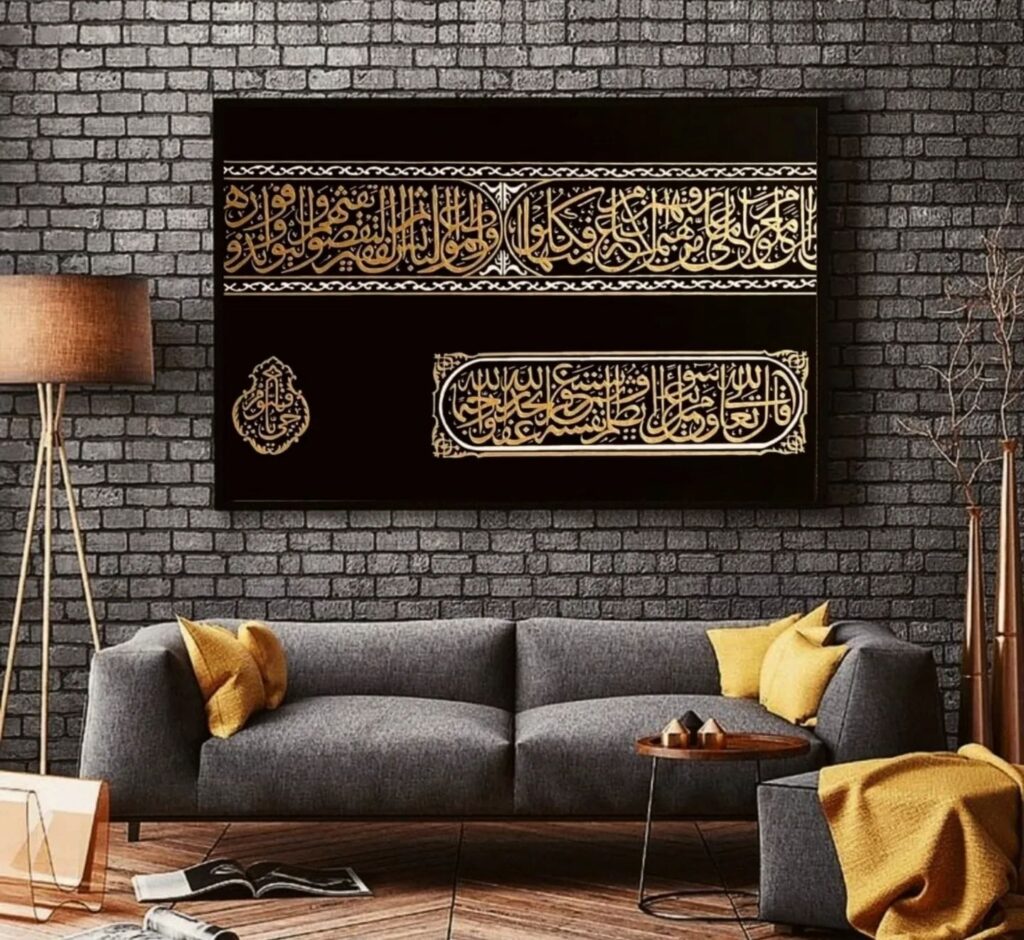
Through centuries, the Kiswa has not only been a testament to the devotion of Muslims to the Kaaba but also a reflection of the changing dynamics of Islamic art and politics. Its history is a fascinating journey through the ages, showcasing the evolution of Islamic civilization and its enduring legacy.
Conclusion
The acrylic portrayal of the Kiswa-e-Kaaba is a masterpiece that intertwines art, faith, and tradition. It celebrates the rich heritage of Islamic artistry, showcasing the intricate details and profound symbolism of the Kiswa. This artwork offers a window into the soul of a faith that reveres beauty, craftsmanship, and the eternal pursuit of connection with the divine. It stands as a testament to the enduring power of religious symbols and the unifying spirit of the Islamic world.
Review
99%
My Experience with PakArt Official This painting of the Kiswa-e-Kaaba is a breathtaking piece of art that captures the essence of one of Islam's most revered symbols. The artist has skillfully depicted the intricate details and majestic grandeur of the Kiswa, bringing to life the spiritual and cultural significance of this sacred cloth. The use of rich, vibrant colors and the meticulous attention to the embroidery, including the Quranic calligraphy, imbue the painting with a sense of reverence and awe. It's a remarkable representation that not only showcases artistic talent but also evokes a deep sense of devotion and respect for the religious traditions it represents. This painting is more than just a visual portrayal; it's a tribute to the profound spiritual connection millions of Muslims have with the Kaaba, making it a truly inspiring and meaningful work of art.
